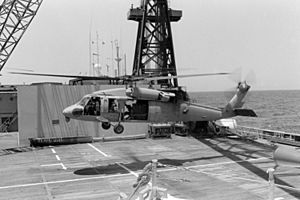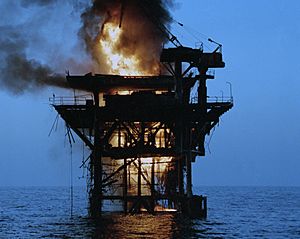Operation Earnest Will facts for kids
Quick facts for kids Operation Earnest Will |
|||||
|---|---|---|---|---|---|
| Part of the Iran–Iraq War | |||||
 A US Navy sailor scans for mines from the bow of the guided missile frigate USS Nicholas during an Operation Earnest Will convoy mission in June 1988 |
|||||
|
|||||
| Belligerents | |||||
Operation Earnest Will was a special mission by the United States military. It took place from July 1987 to September 1988. Its main goal was to protect oil tankers from Kuwait in the Persian Gulf. These tankers were being attacked by Iran during the Iran–Iraq War.
This operation was the biggest naval convoy mission since World War II. A convoy is a group of ships traveling together for protection.
The U.S. Navy played a big part, escorting the tankers. But other military branches helped too. U.S. Air Force planes with special radar (called AWACS) watched for danger. U.S. Army helicopters hunted for attackers.
Many U.S. Navy ships were involved. They came from different fleets around the world. This included Carrier Battle Groups and Surface Action Groups.
This operation was also the first time different U.S. Special Operations teams worked together. This included Navy SEALs, Special Boat Units, and "Nightstalkers" (special helicopter pilots).
Contents
Why the Operation Started
The "Tanker War" was a part of the larger Iran–Iraq War. It began in 1984 when Iraq attacked oil tankers from Iran. Iraq wanted to stop Iran's oil exports. They also hoped Iran would close the Strait of Hormuz. This would have caused other countries to get involved.
Iran mostly attacked Iraqi ships. But Iraq relied on Kuwait to ship its oil. So, Iran started attacking Kuwaiti tankers too. Both countries attacked ships from neutral nations. This was to hurt each other's trade.
In 1987, Kuwait asked the U.S. government for help. They wanted the U.S. Navy to protect their tankers. U.S. law said the Navy couldn't protect ships from other countries. So, Kuwaiti ships were re-registered under the U.S. flag. This meant they became "U.S. ships."
Even before the operation officially began, it was clear it would be dangerous. On May 17, 1987, an Iraqi plane accidentally hit the U.S. Navy ship USS Stark. This attack killed 37 sailors.
How the Operation Worked
Operation Earnest Will officially began on July 23, 1987. Several U.S. Navy ships were assigned to escort the Kuwaiti oil tankers.
The Bridgeton Incident
On the very first mission, a Kuwaiti oil tanker, now called the MV Bridgeton, hit an Iranian underwater mine. This happened on July 24, 1987. The mine was planted by an Iranian special unit.
The Bridgeton was damaged but no one was hurt. It continued to Kuwait on its own power. The U.S. Navy ships followed carefully to avoid more mines.
This incident was widely reported. Iran's Prime Minister said it was a big blow to America's image. It also showed that the U.S. Navy didn't have minesweepers in the Persian Gulf. Minesweepers are ships that clear mines.
Because of this, the U.S. sent special minesweeping helicopters. They also sent more minesweeper ships. This greatly increased the U.S. presence in the Gulf.
Later Missions
For the next 14 months, many U.S. warships took part in escorting duties. At one point, over 30 warships were in the region.
Operation Prime Chance
Operation Earnest Will also included a secret mission called Operation Prime Chance. This mission aimed to stop Iran from attacking ships.
Even with U.S. Navy protection, Iran used mines and small boats to bother the convoys. To fight this, the U.S. Navy used two oil barges. These were turned into mobile sea bases. They were placed in the northern Persian Gulf. This allowed special forces to stop Iranian attacks.
On September 21, 1987, "Night Stalkers" (special helicopter pilots) found an Iranian ship, Iran Ajr. They watched it laying mines. After getting permission, the helicopters attacked the ship. The crew abandoned the ship.
A team of Navy SEALs boarded the Iran Ajr. They found nine mines on deck and a logbook. The logbook showed where other mines had been placed. The ship was later sunk. This logbook proved Iran was laying mines in international waters.
Special operations forces soon learned Iran's pattern. They would hide near oil platforms during the day. At night, they would head out to attack ships. Knowing this, U.S. forces attacked three Iranian boats near a navigation buoy. In a short fight, the U.S. aircraft sank all three boats.
Operation Nimble Archer
On October 15, 1987, a U.S.-flagged tanker, Sea Isle City, was hit by an Iranian missile. This happened near Kuwait City. Many crew members were injured.
The U.S. Navy responded on October 18 with Operation Nimble Archer. Four destroyers shelled two Iranian oil platforms. These platforms were used as bases for attacks. After the shelling, Navy SEALs landed on one platform. They planted explosives to destroy it. They also searched another platform for intelligence.
Operation Praying Mantis
On April 14, 1988, the U.S. frigate USS Samuel B. Roberts hit a mine. This caused a huge hole in its hull and injured 10 sailors.
The U.S. responded strongly on April 18 with Operation Praying Mantis. U.S. forces attacked Iranian ships and oil platforms. They attacked the Iranian ship Joshan and two frigates. They also attacked Iranian bases on the Sirri and Sassan oil fields. After U.S. warships bombed the Sirri base, a helicopter with SEALs tried to land. But the fire was too intense. The platform was soon destroyed by explosions.
The End of the Operation
After these U.S. responses, Iranian attacks on neutral ships dropped a lot.
On July 3, 1988, the U.S. ship USS Vincennes mistakenly shot down Iran Air Flight 655. It was an Airbus passenger plane. All 290 people on board died, including 65 children. This happened over the Strait of Hormuz.
These events, especially Operation Praying Mantis and the plane's downing, helped convince Iran to agree to a ceasefire. Iran and Iraq ended their eight-year war on August 20, 1988.
Operation Earnest Will officially ended on September 26, 1988. The remaining U.S. forces returned home.
Images for kids
-
A US Navy sailor scans for mines from the bow of the guided missile frigate USS Nicholas during an Operation Earnest Will convoy mission in June 1988
See also
 In Spanish: Operación Earnest Will para niños
In Spanish: Operación Earnest Will para niños








